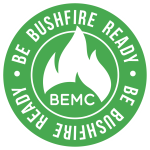Bushfire survival plans are a series of agreed steps which form a bushfire evacuation plan and will be undertaken in the event of a bushfire progressing towards your house. The plan is developed prior to the bushfire season to allow occupants to rationally, sensibly and without time pressures determine what steps they will take. It is important that when developing bushfire survival plans that all members of the household, neighbours and extended family are aware of the final plan.
The most significant elements of a bushfire survival plan and bushfire safety plan is what triggers will the household use to enact the steps of the plan, which we examine in this blog. Moving between the steps can be very fast and a pre-determined plan is required. Accredited bushfire consultants can help determine the bushfire hazard and bushfire risk that necessitate these steps.
Pets and live stock will panic and flee or hide when a bushfire approaches. Importantly, it becomes very noisy and calling for your pet will be difficult. You must make a decision early when considering pets. Are you going to take them with you when evacuating? Where can they be secured? Is there adequate water and food?
Pets – https://www.youtube.com/watch?v=O_h7RZi2DfA
Pets – https://www.youtube.com/watch?v=koUuvsjfOlg
Livestock – https://www.youtube.com/watch?v=4dBM2g_t6E4
Livestock – https://www.youtube.com/watch?v=JkE2PK0vL3Q
What is the capability of elderly, children and disabled during a bushfire event? These vulnerable individuals should be considered when determining your bushfire survival plan.
Vulnerable people – https://www.youtube.com/watch?v=RkBBF6JgUT8
Generally, we can break the bushfire survival plan into six steps.
Step 1 – Knowledge of bushfire protection measures and how they protect you and your home.
Bushfire Protection Measures include separation (Asset Protection Zones), water provisions, construction standards, access (emergency and evacuation) and management of hazardous materials such as gas and electricity.
Step 2 – Awareness of bushfire weather conditions.
The current bushfire planning and construction measures work well to protect your home and life when fire danger ranges from low to high. These measures are tested during very high fire danger days and are considered unreliable at extreme and catastrophic levels. The actions within the resulting steps will differ for different fire weather conditions and if your building complies with all contemporary bushfire protection measures.
Step 3 – Awareness of the ignition of a fire.
The identification of a smoke column and confirmation on NSW Fires Near Me App are the most common methods.
Step 4 – Awareness the bushfire is approaching your house.
If you can see a dark smoke column (indicating hard burning), the column is not tilting and the wind is in your face when looking at the smoke column, the bushfire is moving towards you. Fire spread can also be determined on the aforementioned NSW Fires near me App.
Step 5 – When to shelter.
The actions within this step will be determined by the fire weather, which is a key driver of bushfire behaviour. Sheltering is a feasible option if your home is compliant will all contemporary bushfire protection measure requirements and the fire weather is at the lower end of the scale.
Step 6 – When to evacuate.
As in step 4, The actions within this step will be determined by the fire weather. Evacuation is a serious consideration during high, extreme and catastrophic fire weather.
As accredited bushfire consultants, we help you determine the quality of your bushfire protection measures and how they impact on your decision.







